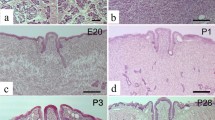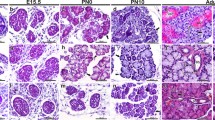Summary
Lectin binding was studied in the developing submandibular glands of fetal Syrian golden hamsters (Mesocricetus auratus) from gestational day 12 to 16 (the day of birth). The fetuses were fixed, embedded in paraffin, sectioned and stained with nine lectin-horseradish peroxidase conjugates: concanavalin A (Con A), wheat germ agglutinin (WGA), Dolichos biflorus agglutinin (DBA), Helix pomatia agglutinin (HPA), Maclura pomifera agglutinin (MPA), Griffonia simplicifolia agglutinin I-B4 (GSA I-B4), peanut agglutinin (PNA), Ulex europens agglutinin I (UEA I) and Limulus polyphemus agglutinin (LPA). The developing glands showed dramatic morphological alterations on a daily basis, accompanied by progressive changes in lectin staining. On day 12 the primitive gland showed only trace lectin staining with WGA, HPA, MPA, PNA and UEA I, but by day 13, strong staining with these lectins, as well as with DBA, was seen at the ductal lumenal surface, after the formation of the ductal lumens. Secretory granules first appeared in cells of the primitive acini on day 14; the secretion products were stained strongly with WGA, DBA, HPA, MPA, PNA and UEA I. On day 15, the secretion products were also stained moderately with GSA I-B4. Secretory differentiation was further developed on day 16, but the staining intensity of the mucins with the different lectins varied among the secretory cells. LPA failed to stain any part of the gland throughout the observation period, and Con A stained only glycogen.
Similar content being viewed by others
References
Barka T (1980) Biologically active polypeptides in submandibular glands. J Histochem Cytochem 28:836–859
Borghese E, Laj M, Di Caterino B (1974) Acinar ultrastructure of the submandibular gland of Mus musculus during embryonic development. Cell Tissue Res 150:425–442
Boyer CC (1953) Chronology of development for the golden hamster. J Morphol 92:1–37
Chaudhry AP, Montes M, Cutler LS (1972) Structural and functional maldevelopment of salivary glands. In: Rowe NH (ed) Symposium on salivary glands and their secretion. University of Michigan Press, Ann Arbor, pp 59–93
Chaudhry AP, Schmutz JA, Cutler LS, Sunderraj M (1983) Prenatal and postnatal histogenesis of myoepithelium in hamster submandibular gland. An ultrastructural study. J Submicrosc Cytol 15:787–798
Colony PC, Steely J (1987) Lectin binding patterns in developing rat colon. Gastroenterol 92:1116–1126
Cunha GR (1972) Support of normal salivary gland morphogenesis by mesenchyme derived from accessory sexual glands of embryonic mice. Anat Rec 173:205–212
Cutler LS, Chaudhry AP (1974) Cytodifferentiation of the acinar cells of the rat submandibular gland. Dev Biol 41:31–41
Cutler LS, Chaudhry AP (1975) Cytodifferentiation of striated duct cells and secretory cells of the convoluted granular tubules of the rat submandibular gland. Am J Anat 143:201–218
Devi NS, Jacoby F (1966) The submaxillary gland of the golden hamster and its post-natal development. J Anat 100:269–285
Downs F, Harris R, Herp A (1976) The isolation and properties of a glycoprotein from hamster submaxillary gland. Arch Oral Biol 21:307–311
Dvořák M (1969) The secretory cells of the submaxillary gland in the perinatal period of development in the rat. Z Zellforsch Mikrosk Anat 99:346–356
Flon H, Gerstner R (1968) Salivary glands of the hamster. I. The submandibular gland: a histochemical study after preservation with various fixatives. Acta Histochem 31:234–253
Gallagher JT, Corfield AP (1978) Mucin-type glycoproteins-new perspectives on their structure and synthesis. Trends Biochem Sci 3:38–41
Goldstein IJ, Poretz RD (1986) Isolation, physicochemical characterization, and carbohydrate-binding specificity of lectins. In: Liener IE, Sharon N, Goldstein IJ (eds) The lectins. Properties, functions, and applications in biology and medicine. Academic Press, Orland, pp 33–247
Goldstein IJ, Hughes RC, Monsigny M, Osawa T, Sharon N (1980) What should be called a lectin? Nature 285:66
Herp A, Wu AM, Moschera J (1979) Current concepts of the structure and nature of mammalian salivary mucous glycoproteins. Mol Cell Biochem 23:27–44
Ito T, Newki C, Strum J, McDowell EM (1990) Changes in glycoconjugates revealed by lectin staining in the developing airways of Syrian golden hamsters. Anat Rec 228:151–162
Kornfeld R, Kornfeld S (1980) Structure of glycoproteins and their oligosaccharide units. In: Lennarz WJ (ed) The biochemistry of glycoproteins and proteoglycans. Plenum Press, New York, pp 1–34
Laden SA, Schulte BA, Spicer SS (1984) Histochemical evaluation of secretory glycoproteins in human salivary glands with lectinhorseradish peroxidase conjugates. J Histochem Cytochem 32:965–972
Maylié-Pfenninger M-F, Jamieson JD (1980) Development of cell surface saccharides on embryonic pancreatic cells. J Cell Biol 86:96–103
Menghi G (1984) Reactivity of peroxidase-labeled lectins in rabbit submandibular and sublingual glands. Acta Histochem 75:27–35
Menghi G, Accili D, Bondi AM, Gabrielli MG (1989) Enzymatic degradation and quantitative lectin labeling for characterizing glycoconjugates which act as lectin acceptors in cat submandibular gland. Histochemistry 90:331–338
Menghi G, Vitaioli L, Bondi AM, Materazzi G (1981) Glycoconjugates in salivary glands of rats during postnatal development. Anat Anz 149:226–231
Naito R, Takai Y, Tsukitani K, Asano K, Mori M (1983) Use of lectins for differential localization of secretory materials of granular convoluted tubules and ducts in the submandibular gland. Acta Histochem Cytochem 16:483–493
Nakai M, Tatemoto Y, Mori H, Mori M (1985) Lectin-binding patterns in the developing tooth. Histochemistry 83:455–463
Pigman W (1977) Submandibular and sublingual glycoproteins. In: Horowitz MI, Pigman W (eds) The glycoconjugates. Vol 1.M Mammalian glycoproteins and glycolipids. Academic Press, New York San Francisco London, pp 137–152
Pinkstaff CA (1980) The cytology of salivary glands. Int Rev Cytol 63:141–261
Roche A-C, Schauer R, Monsigny M (1975) Protein-sugar interaclions. Purification by affinity chromatography of limulin, an N-acyl-neuraminidyl-binding protein. FEBS Lett 57:245–249
Schulte BA, Spicer SS (1983) Light microscopic detection of sugar residues in glycoconjugates of salivary glands and the pancreas with lectin-horseradish peroxidase conjugates. I. Mouse. Histochem 115:1217–1238
Schulte BA, Spicer SS (1984) Light microscopic detection of sugar residues in glycoconjugates of salivary glands and the pancreas with lectin-horseradish peroxidase conjugates. II. Rat. Histochem J 16:3–20
Schulte BA, Spicer SS, Miller RL (1985) Lectin histochemistry of secretory and cell-surface glycoconjugates in the ovine submandibular gland. Cell Tissue Res 240:57–66
Shackleford JM, Klapper CE (1964) Structure and carbohydrate histochemistry of mammalian salivary glands. Am J Anat 111:25–47
Shiojiri N, Katayama H (1988) Development of Dolichos biflorus agglutinin (DBA) binding sites in the bile duct of the embryonic mouse liver. Anat Embryol 178:15–20
Spicer SS, Duvenci J (1964) Histochemical characteristics of mucopolysaccharides in salivary and exorbital lacrimal glands. Anat Rec 149:333–358
Spooner BS, Faubion JM (1980) Collagen involvement in branching morphogenesis of embryonic lung and salivary gland. Dev Biol 77:84–102
Takai Y, Murase N, Hosaka M, Sumitomo S, Noda Y, Mori M (1986) Comparison of lectin binding patterns in salivary glands of mice and rats with special reference to different fixatives used. Acta Histochem 78:31–47
Yamashina S, Barka T (1973) Development of endogenous peroxidase in fetal rat submandibular gland. J Histochem Cytochem 21:42–50
Young JA, van Lennep EW (1978) The morphology of salivary glands. Academic Press, London New York San Francisco
Author information
Authors and Affiliations
Additional information
This work was supported by National Institutes of Health Grant HL37640.
Rights and permissions
About this article
Cite this article
Ito, K., Ito, T., Strum, J.M. et al. Lectin histochemistry of developing submandibular glands of fetal Syrian golden hamsters. Anat Embryol 183, 135–141 (1991). https://doi.org/10.1007/BF00174394
Accepted:
Issue Date:
DOI: https://doi.org/10.1007/BF00174394




